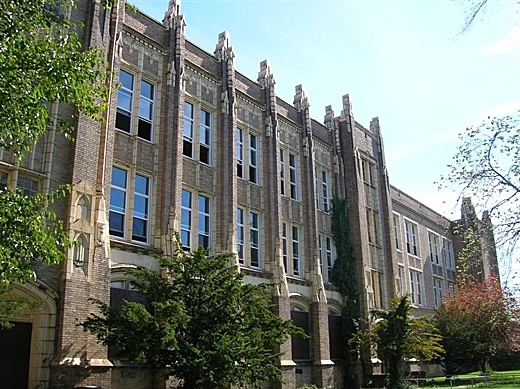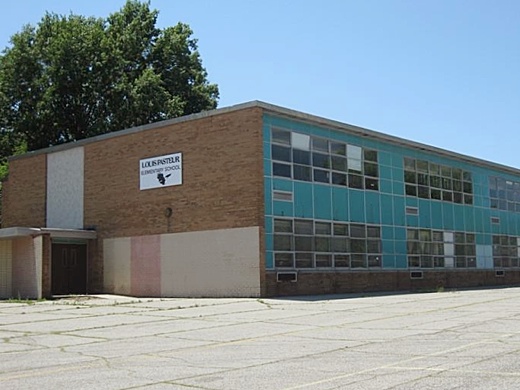 Image above: The Alexender Hamilton Junior High School in Cleveland, Ohio, built the year before the 1929 Crash. From (http://www.oldohioschools.com/cuyahoga_county.htm).
By James Kunstler on 15 March 20210 in Kunstler.com -
(http://kunstler.com/blog/2010/03/where-have-we-been-where-are-we-going.html)
Driving down the broad avenues of Cleveland, Ohio, was like flipping through the pages of a picture book about the rise and fall of our industrial empire. Where demolitions had not removed things -- a lot was gone -- stood the residue of a society so different from ours that you felt momentarily transported to another planet where a different race of beings had gone about their business.
Image above: The Alexender Hamilton Junior High School in Cleveland, Ohio, built the year before the 1929 Crash. From (http://www.oldohioschools.com/cuyahoga_county.htm).
By James Kunstler on 15 March 20210 in Kunstler.com -
(http://kunstler.com/blog/2010/03/where-have-we-been-where-are-we-going.html)
Driving down the broad avenues of Cleveland, Ohio, was like flipping through the pages of a picture book about the rise and fall of our industrial empire. Where demolitions had not removed things -- a lot was gone -- stood the residue of a society so different from ours that you felt momentarily transported to another planet where a different race of beings had gone about their business.
Among the qualities most visible in the recent ruins of that lost society is the secure confidence expressed in its buildings. Even the most modest factory or business establishment built before the 20th century included decorations and motifs devised for no other reason but to be beautiful -- towers, swags, medallions, cartouches -- as if to state we are joined proudly in a great enterprise to make good things happen in this world. This was true not just of Cleveland, of course, but the whole nation, for a while anyway.
Equally arresting are the changes visible in the collective demeanor from the mid-20th century, especially after the Second World War, when the adolescent panache of a rising economy had morphed into the grinding force of a place devoted to the production of anything. The memory of the Great Depression lingered like a metabolic disorder, and the spirit of the place was no longer caught up in the muscular exuberance of self-discovery but the sheer determination to stay powerful and alive. This phase didn't last long.
By the 1970s, signs of a new illness were clear. Production was moving someplace else, incomes and household security with it. An existential pall settled over the city as ominous symptoms of waning vitality showed up in the organs of production. Steel-making and car-making staggered. Even the Cuyahoga river caught on fire, as if fate was a practical joke. Major retail was moving elsewhere -- to the suburban outlands -- where so many of the people who worked in the downtown towers had already fled. The population that remained in the city center was made of recently uprooted agricultural quasi-serfs who had only just come up to the city a generation before to make better livings in the factories that were all of a sudden shutting down. It seemed like a kind of swindle and they were understandably angry about it.
These days, reading what remains of the city by the lake -- like so many other cities on the lakes and big rivers of the USA heartland -- you see a place outfitted for different obsolete pasts with almost no sense of a plausible future. Most of the efforts directed at "economic development" in our industrial cities have been aimed at recapturing those pasts, and it is not surprising that they uniformly fail, because we are not going back there. We could conceivably take ourselves toward futures to be proud of, but they are not likely to be the kind of futures we are so busy projecting in our techno-grandiose fantasies about machine "singularities."
 Image above: The Louis Pasteur Elementary School in Cleveland was built only 30 years later. Look at the architecture and landscaping to see what happened to the city... and America. From (http://www.oldohioschools.com/cuyahoga_county.htm).
Image above: The Louis Pasteur Elementary School in Cleveland was built only 30 years later. Look at the architecture and landscaping to see what happened to the city... and America. From (http://www.oldohioschools.com/cuyahoga_county.htm).
 Image above: The Louis Pasteur Elementary School in Cleveland was built only 30 years later. Look at the architecture and landscaping to see what happened to the city... and America. From (http://www.oldohioschools.com/cuyahoga_county.htm).
Image above: The Louis Pasteur Elementary School in Cleveland was built only 30 years later. Look at the architecture and landscaping to see what happened to the city... and America. From (http://www.oldohioschools.com/cuyahoga_county.htm).
Being an actualist, I'm in favor of getting real about things, and the reality we've entered is one of comprehensive contraction, especially for our cities. One of the reasons places like Cleveland (and Detroit, and Milwaukee, and St Louis, and Kansas City....) continue to fail in their redevelopment efforts is because they are already too big. They became overgrown organisms a while ago, unsuited to the realities of the future -- especially the energy resource realities of the future -- and they have tried everything except consciously contracting into smaller, finer, denser, differently-scaled organisms. In fact, the trend up until the so-called housing bubble of recent years was to just keep on expanding ever outward beyond the suburban frontier, which left our cities in a condition like imploded death-stars -- cold and inert at the center, with debris speeding uselessly outward to an unreachable infinity.
This future we're entering, which I call the long emergency, compels us to imagine our society differently. Our cities and towns exist where they do because they occupy important sites. Cleveland is where a significant river empties into the world's greatest inland sea (which has the additional amazing benefit of being fresh water). Some human settlement will continue to be there, very probably a place of consequence, but it will not be run under the same circumstances that produced, for instance, the civic center of Daniel Burnham with its giant Beaux Arts courthouses, banks, and municipal towers.
This disintegrating nation is woefully distracted by Web 2.0, iPads, Avatar movies, Facebook, and the idiot celebrity spectacles of TV, not to mention the disasters of job loss, foreclosure, medical extortion, bankruptcy, corporate loot-ocracy, and the squandered moments of politics. We know we have to go somewhere. We know that something like history is leaving us behind. We have no idea how to get to a new place. And we're spending most of our mental energy gaping into the rear-view mirror, which is the last place to look for your destination.
The confusion is apt to get a lot worse before it gets better. I'm not saying this to be ornery but because I believe it is true, and it will benefit us to know the odds we're up against. The confusion is going to generate a lot of ideas that are inconsistent with reality -- especially involving the seductive nostrums of technocracy. Our redemption will be found closer to the ground in the things we do by hand. But we don't know that yet, and we're going to try everything except looking there before we find out.
.
1 comment :
Cleveland in 1963:
In 1963, I made a trip to Cleveland from rural Western New York. My hometown was Jamestown, NY, a very small city of 40,000, between Buffalo,NY and Erie, PA. I was 10 years old, and traveling to Cleveland Clinic for a comprehensive evaluation of my Asthma and Allergies.
As the oldest of 5 children, this was the first time I had traveled alone with my parents, without all the little brothers and sisters.
I was blown away by the urban sophistication of Cleveland in 1963! I had never stayed in a Hotel (only Motels), or ridden in a cab, or ever seen so many black people. I was the product of white, small town America: granddaughter of poor Appalachian farmers and Sicilian immigrants, and was really impressed by Cleveland, the first big city I had experienced.
A salesman friend of my father's met us and took us to dinner at a fancy restaurant. I was mesmerised by the big city lights on the wet pavement on a rainy night in Cleveland! I was horrified that black maids were waiting in the restrooms to hand me a towel!
This was the first time I was treated as a semi-adult, and then taken to a club with a semi-famous singer performing. I think it may have been Vic Damone.
Anyway, reading Kunstler's post, and realizing how far Cleveland had fallen, I was just overwhelmed by these memories of a vibrant city. Admittedly, Cleveland already had some major problems even in '62.
I would like to see the Rust Belt cities like Cleveland, Detroit, Toledo, Gary, and Buffalo develop into some sustainable, productive cities of manageable size once again.
Post a Comment